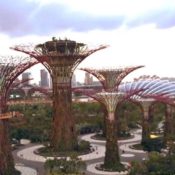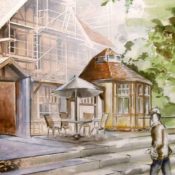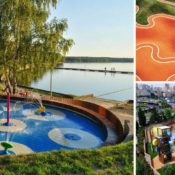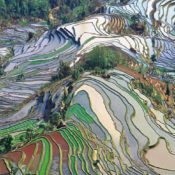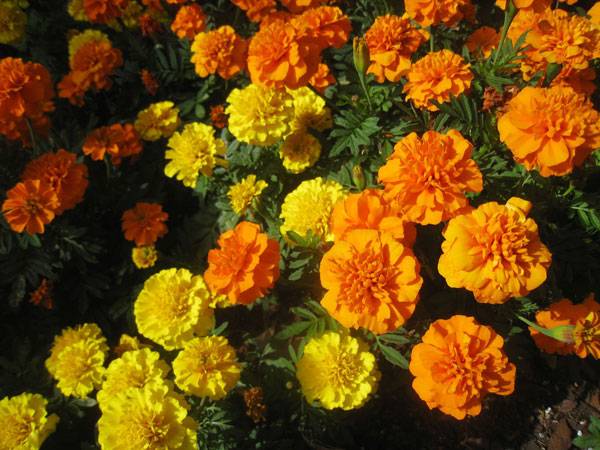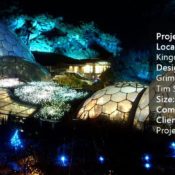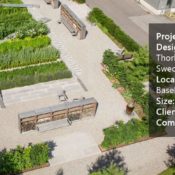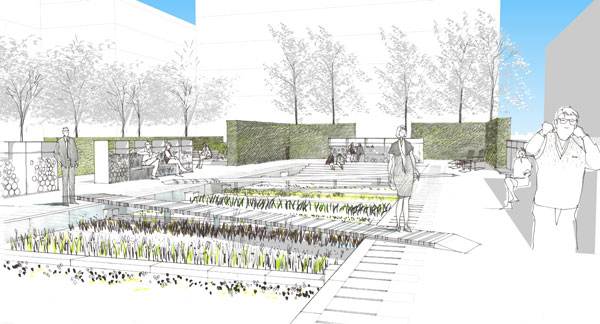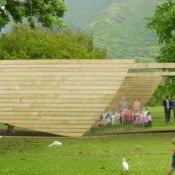Author: Taylor Allen
6 Top Shows and Expos for Landscape Architects You Don’t Want to Miss
Article by Amela Đurakovac – We highlight 6 top shows and expos for landscape architectures that are packed with information and inspiration to keep you motivated. In the field of landscape architecture, there are many events over the year bringing together all the great news from the profession. In almost all countries, organized events are held which have a lot to offer like a variety of workshops, lectures, seminars with exhibitions, installations, trending products, new services, key skills and new trends and they represent a real pleasure for all visitors and exhibitors. In addition to offering knowledge and entertainment, these events also may provide important business opportunities for every professional. Every landscape architect should know where some of the best shows and expos take place and visit them if there is a possibility for it. The list of such events is very long and all are equally important. Sometimes, choosing the right show or expo for a visit demands good information about the event and preparation. Here are just some of the events that every landscape architect should visit at least once in their lives.
Shows and Expos for Landscape Architects
1. Landscape Show, London
Many seminars with leading trending products from the profession of landscape architecture can be seen in this show. This is truly an opportunity for all suppliers or manufacturers to exhibit here and visitors can meet with representatives who offer products such as artificial trees, artificial turf, decking, flooring, fencing, water features, water fountains, commercial furniture, garden furniture, garden buildings, lighting, irrigation, living walls, living roofs, metalwork, outdoor kitchens, barbecues, outdoor fireplaces, sculptures, planters, containers, pools, hot tubs, spas, soils, composts, structures, mulches, stone, paving, aggregates, commercial lighting, tools, and much more.
WATCH >>> The Landscape Show 2015, London
2. Singapore Garden Festival This event is a joy for those who want to escape from everyday life and enjoy the beautiful creations that stretch to the spectacular borders of design. World-renowned and award-winning designers are responsible for all these creations. In addition, this festival is characterized by a series of performances by popular local artistes, music of different genres, and a marketplace. What is perhaps most interesting is the landscape design challenge where teams race against time to create one type of garden for a limited–time display: WATCH >>> Singapore Garden Festival 2014
3. World Congress of the International Federation of Landscape Architects (IFLA)
The IFLA congress is one of the most significant events for all landscape architects, held each year in a different country. Representatives from all countries find their place in this gathering, which deals with many topics in the landscape architecture profession, current projects, and education. This event is itself a large show because it gathers experts that are involved in the knowledge, analyses, active conservation, design and management of open spaces and also younger students and professionals who want to progress.
4. International Biennial of Landscape Architecture, Barselona
The first biennal of landscape architecture was organized in the year 1999 with the desire to gather landscape architects and students not only from Europe but from all over the world. With many associations in support, the biennial became a professional point; a symposium where they hold conferences and one of the main features of this event is the Rosa Barba Landscape Prize awarded to the best projects. Each biennial carries Each biennial carries symbolic name as the main topic. Some of the names of previous biennials are :“Remaking Landscapes” (1999), “Gardens in Arms” (2001), “Only with Nature” (2003), “Landscape: a Product/a Production” (2006)— “Storm & Stress” (2008), “Liquid Landscape” (2010) and “Biennial versus Biennial” (2012).
5. Expo Milano, Italy
The first Expo in Milano was held in the year 2008 and since then, it can be said that this event became the very symbol of Milan. More than 20 million visitors, 150 participants and about 5000 events – the total duration is 184 days – wow, that is really a statistic that shows the quality of contents that can be seen here! People who visit the expo are going home with a lot of enthusiasm, due to many facilities dealing with life issues and the future. Other features have included pavilions, clusters and important heritage, projects of biodiversity, and the impact of climate change on food production, the economy, and society. Many important and famous people like Ban Ki Moon, Angela Merkel and others also visited this expo and increased the importance of this event. WATCH >>> Expo Milano 2015, Milan, Italy – Crystal Fountains
6. The ASLA Annual Meeting and EXPO
One of the greatest and also one of the largest events in the field of landscape architecture is held every year in different cities throughout the United States. The ASLA Expo each year offers new products, services, technology applications, and design solutions through exclusive show hours . All participants of this event are very satisfied because of the benefits offered to exhibitors and the visitors are even more pleased because of all the phenomenal chance for their professional development. Every ASLA meeting offers many courses and workshops and if you are not up-to-date with the news in landscape architecture, here you will certainly come to know all about it. WATCH >>> Watch ASLA Annual Meeting and EXPO Highlights
Shows and Expos for Landscape Architects
Why are these events really important? Because the profession of landscape architecture is constantly evolving and brings amazing opportunities with the help of which we can be very professional and creative in our work. All these gatherings can help you meet quality people or to create a platform to promote your product or service. Now knowledge is an infinite thing, you can always learn something, make new experiences, gain contact with new technologies, release your everyday stress and enjoy networking with new friends, discover new design solutions and go home with a great deal of inspiration. There’s nothing to lose, that’s for sure! What shows and expos for landscape architects would you recommend? Let us know in the comments!
Recommended Reading:
- Becoming an Urban Planner: A Guide to Careers in Planning and Urban Design by Michael Bayer
- Sustainable Urbanism: Urban Design With Nature by Douglas Farrs
Article by Amela Đurakovac
Is Drawing a Natural Talent?
We take a look at the question “Is Drawing a Natural Talent?” and help to understand what lies beyond the artist and their abilities. When it comes to drawing as a form of art, there are many facts and suggestions dealing with the power of this form of communication and also many books and tutorials, where every day we can see examples of excellent drawings and drawing techniques. Whether they are done with pencils, pen, ink, fiber-tip pens, chalk, charcoal, crayons, pastels, digital drawing or a combination of all these techniques, we look at them with much enthusiasm and admiration. Some of the drawings look so real that we can not even tell whether they are pictures or drawings. For those who are not sure how to overcome the overwhelming choices between all these drawing techniques and wonder whether can drawing be learned, we asked one question: Is drawing a natural talent? Are we are somehow predisposed to be great artists or architects from early childhood or must we work on ourselves to improve our drawing skills?
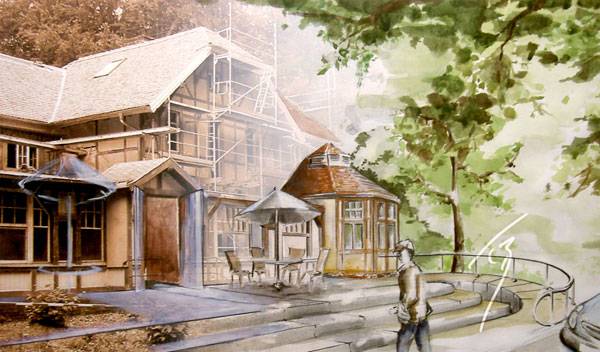
The image featured in Sketchy Saturday. By Tino Beck, self-employed artist, Germany.
Every Artist Was First an Amateur
If we look back at the best artists of all time, we will find something in common; they were all people who learned drawing and practiced and practiced every day. From Leonardo da Vinci to Picasso and others, they all loved to draw

“Mona Lisa, by Leonardo da Vinci, from C2RMF retouched” by C2RMF: Galerie de tableaux en très haute définition: image page – Cropped and relevelled from File: Mona Lisa, by Leonardo da Vinci, from C2RMF.jpg. Originally C2RMF: Galerie de tableaux en très haute définition: image page. Licensed under Public Domain via Commons
Learning How to Draw
Everyone can draw, it’s true, but the question is; what really is the boundary between a “beautiful” drawing and a masterpiece? Can one masterpiece be explained and set with some standard of drawing? Many people think that the great artists were all born with supernatural talent. Yes, in relation to others, they maybe had some skills, like an eye for details, an innate sense of composition, an attenuated perception of objects being drawn, the ability to make good representational decisions, and the deft motor skills required for mark-making, but even they had to advance their talent with much practice and accumulation of knowledge. WATCH: Start Drawing: PART 1 – Outlines, Edges, Shading
Keep Calm And Draw
Every beginning is hard, but it should not be a problem if you really want to learn how to draw. When you know how much time you need for drawing, the main reason that inspires you, your own sources of creativity, and how to develop your intuitive impulses for drawing, you can start creating your own unique drawings.
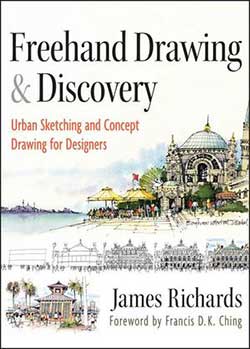
Freehand Drawing & Discovery by James Richards, click here and get the book
” Talent is good, practice is better, passion is best “
At what point you can call yourself an artist? When you make your drawings simple. When you make them with love. When you make them with passion. You don’t need to be the best of the best to produce great drawings. Over time, the results of practice will start to show and you will be able to enjoy your drawings. In his excellent book “Drawing the Landscape“, Chip Sullivan says: “I love to draw! I love to draw almost more than anything else in the world. It brings me solace, excitement, and the thrill of experimentation. When I am feeling low, drawing can make me happy. With a single piece of paper and a mark-making tool, I can create whole new worlds. Drawing allows you to design environments capable of
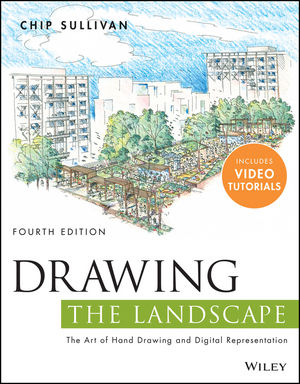
Front cover of Drawing the Landscape
Chip Sullivan.
Recommended Reading:
- Drawing and Designing with Confidence: A Step-by-Step Guide by Mike W. Lin
- Landscape Perspective Drawing by Nicholas T. Dines
Article by Amela Djurakovac Return to Homepage Featured image from Sketchy Saturday. By Tino Beck, self-employed artist, Germany.
The 10 Best Playgrounds of the World
If a space is suitable for children, it’s suitable for everyone. We take a look at 10 of the best playgrounds we could find and look at what makes them so special. If we look at areas designed for children, we see that they are all different, even though they fulfill the same purposes: fun, stimulation of children’s imagination and creativity, and socialization. They must also be safe and secure. Some of the best playgrounds are small, some are spacious, some are thematic or mysterious, some contain a variety of equipment, and some are very simple. Whether they are modern and urban or made from recycled materials, each of these playgrounds is unique in its own way. There are a large number of really awesome playgrounds, but here is our list of the top 10 best playgrounds of the world, which every child would love to visit and discover.
10. The Playground at Parque Gulliver, Valencia, Spain
Anyone who knows the story of Gulliver and the Lilliputians can assume what this playground is designed for. A giant Gulliver lies sprawled on the ground. His body is actually a place to play, and the children are like Lilliputians who “walk” on his body. Each part is a special place to play — a slide, a ramp, scales, a cave.
WATCH: Tilt-Shift | Parque Gulliver | Valencia
9. Clemyjontri Park, Mclean, Virginia, United States
This is a playground for children of all abilities, offering swings, slides, and play equipment and a colorful view from the top of the pathways. The playground is divided into four rooms: the Rainbow Room, the Schoolhouse & Maze Room, the Fitness & Fun Room, and The Movin & Groovin Room. Each contains play and educational facilities and activities, such as a surface with the colors of the rainbow and a variety of swings, learning panels in the form of a maze, themed equipment (a racetrack, motorcycles, planes, and trains), and jungle gym components. Who could resist?
WATCH: Clemyjontri Park- Mclean, VA
8. Wright Brothers Playground, New York City, United States
As the name says, this is a themed playground with airplane-inspired play structures. Children of different ages can enjoy exploring the area. Like real pilots, children can even command the cabin of airplane! There are also signs indicating the characteristics of the first flight of the Wright brothers, rings and net climbers, swiggle stix, bridge and wobble pod bouncers, and more activities that can help children to have fun and practice their muscle strength.
WATCH: Wright Brothers Playground – New York, NY – Visit a Playground – Landscape Structures
7. A Toddlers Playground, Alfortville, France
Design in accordance with what kids need in their development — this is what characterizes this space. Many activities allow children to actively participate in the games. The playground is divided into three main parts: plot, adult area, and children’s area. The whole area is designed in levels, with different colors and textures so children can enjoy various sounds and develop their senses while also learning about the environment.
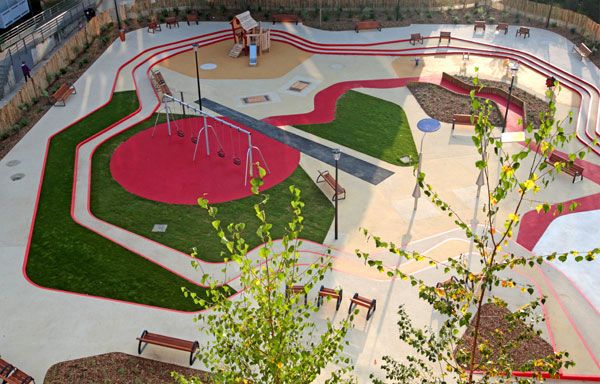
A Toddlers Playground. Photo courtesy of Espace Libre
6. BUGA 05 Playground, Munich, Germany
This playground is not a typical one. It does not contain the typical elements seen in many other playgrounds, but it is very interesting and contemporary. The inspiration for this playground is a relief that is presented here by combining two elements — grass and tartan — to form a corrugated, wavy surface that encourages children to walk and leap and also creates a feeling of being in a natural landscape. It is simply beautiful!
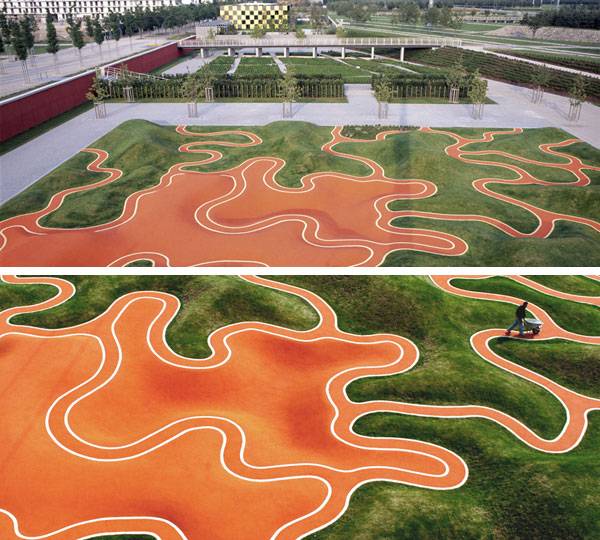
Images courtesy of Rainer Schmidt Landschaftsarchitekten. Top photo credit: Müller Naumann. Bottom photo credit: picture- alliance /dpa / Andreas Gebert
5. Van Campenvaart Playground, Hague, The Netherlands
Van Campenvaart playground is designed with the idea of “Natural Play”. The shape of the playground is like a red blanket, with many folds and ramps, because it is designed to welcome children with special needs. All children can play together and help each other. Elements such as climbing grips and tactile elements, a moving rubber mat, whisper tubes, a wide slide, a “concave” revolving disc and a hammock allow children to expand their boundaries and overcome barriers. See These Playground Related Articles:
- How “A Toddlers Playground” Inspires Learning
- Zorlu Center, The Playground Where Imagination Comes to Play
- How the Van Campenvaart Playground is Breaking Boundries
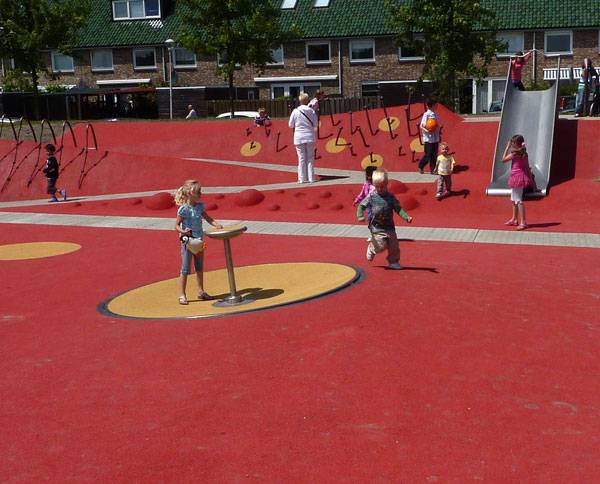
Van Campenvaart. Image courtesy of Carve
3. Base Playground, Belleville-Park, Paris 13, France
This playground takes full advantage of the terrain’s topography with a combination of wood, concrete, and parts of trees that create slopes that offer children a collection of different contents. It includes various passages, winding terrain, a gazebo, climbing ropes, and other features that are completely urban and push the boundaries of standard playgrounds by offering spatial and visual communication. See this awesome playground on Landezine
4. Water Playground, Tychy, Poland
This is not only a playground, it is a pleasure for the eyes! The main motive for the design was to create a water playground within the landscape. The shape of the field is like a swimming pool — even the bottom color is blue — surrounded by wooden benches. Within the playground are aquatic toys and flower fountains that spray water. This is the perfect playground for children, especially on hot summer days. At night, LED bulbs create a beautiful new atmosphere.
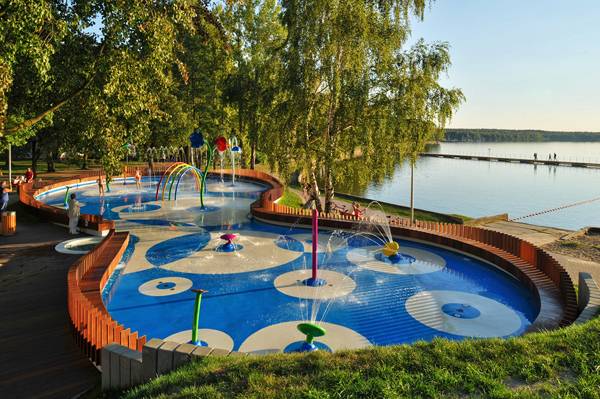
Water Playground, Tychy, Poland. Photo credit: Tomasz Zakrzewski / archifolio.pl
2. Playground at Zorlu Centre, Istanbul, Turkey
This is an adventure playground that creates an unforgettable experience! It is divided into several zones that represent special worlds. The playground is intended for both small and older children, with hills, capricious play shapes that host numerous play elements for the smaller children, with elements such as trampolines, spinners, climbing nets, hammocks, and slides. Walls, valleys, hills, water elements, and towers create a sense of adventure.
- How “A Toddlers Playground” Inspires Learning
- Zorlu Center, The Playground Where Imagination Comes to Play
- How the Van Campenvaart Playground is Breaking Boundries
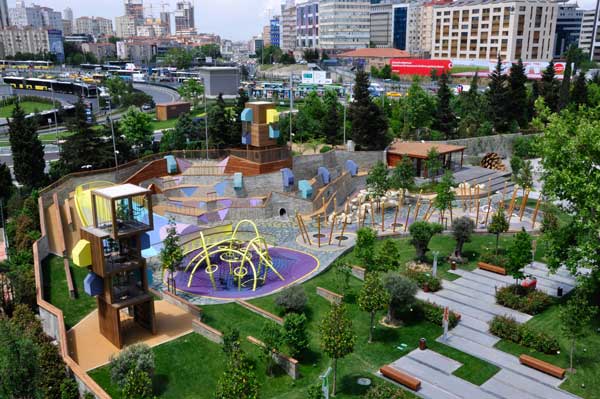
Zorlu Center. Photo credit: Oguz Meric
1. Lazy Dayz Outdoor Children’s Playground, Owensboro, Kentucky, United States
The most important thing about this playground is that it is accessible and barrier free. The area of the playground is very large, and all play elements have been carefully selected. Interactive spray fountains, multifunctional playing elements, colors, and materials ensure that all children will really enjoy this place.
WATCH: Smothers Park in Owensboro, Kentucky
What are the elements that make child’s play interesting and innovative? There are many such spaces that serve not only as a playable environment for children, but also affect their development. The design of playgrounds today goes beyond just providing a place to climb and jump. It is the landscape architect’s job to design the best possible places for our children. Share your favorite playgrounds and innovations in children’s design in the comments below. Recommended Reading:
- Designing the Sustainable Site: Integrated Design Strategies for Small Scale Sites and Residential Landscapes by Heather L. Venhaus
- Lifelong Landscape Design by Hugh Dargan
Article by Amela Đurakovac Return to Homepage
10 Most Culturally Significant Plants from Around the World
10 culturally significant plants that have shaped how we see the world. Plants are all around us. Their relationship with humans is a long one, so it is not surprising that people have always adored plants and had a special connection with some of them. This relationship is sometimes so strong that people turn to plants to honor some of the most important moments in life: birth, marriage, death. Plants are also used in many cultural ways — in medicine, as religious objects, as subjects in mythology, as food, and in many festivals, celebrations, and traditions. Some plants symbolically represent a country as the national symbol. Although it could be said that all the plants are culturally important, here is a look at the Top 10 most culturally significant plants from around the world.
Culturally Significant Plants
10. Tea (Camellia sinensis) Tea originated in Asia. It was grown in China for several thousand years before being cultivated in other parts of the world. All tea leaves (except vegetable and fruit) come from the same bush evergreen plants, which have the Latin name Camellia sinensis. In England, everybody loves to have a “tea break” in the afternoon, and in Japan, special tea-drinking ceremonies are an important cultural tradition.
9. Rice (Oryza sativa) Rice is not just food in Japan; it also holds both historical and contemporary meaning. Rice has been cultivated across the country for more than 2,000 years. All parts of the rice plant are utilized, with the largest part being recycled into tatami mats and bran providing a facial scrub. Rice is present in many aspects of Japanese life — in everyday meals, in New Year celebrations, and for family rituals. Fields of rice are among the most fascinating parts of the Japanese landscape.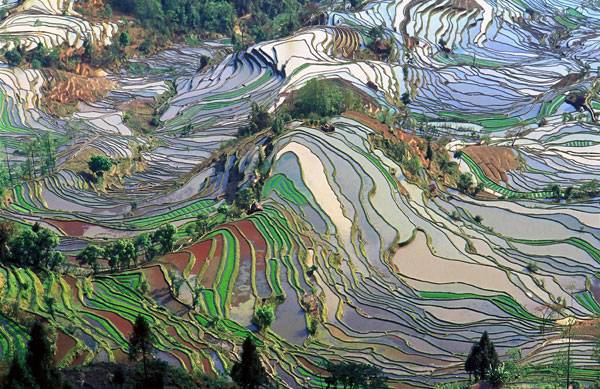
Abstract pattern of terraced rice fields in Yuanyang County. Photo credit: Jialiang Gao, www.peace-on-earth.org – Original Photograph. Licensed under CC 3.0. Image source.

Henna art. Photo credit: Licensed under CC0 Public Domain. Image source.
- 10 of the Most Common Mistakes People Make in Planting Design and How to Avoid Them
- Interested But Not Confident? – Know How to be Good at Hand Drawings
- Top 10 YouTube Tutorials for Technical Drawing

Parc de Bagatelle in Paris. Licensed under CC BY-SA 3.0. Image source.

United States President Barack Obama and Taoiseach Enda Kenny from Ireland. Photo credit: Licensed under Public Domain. Image source.

Major Oak. Photo credit: Immanuel Giel. Licensed under Public Domain. Image source.
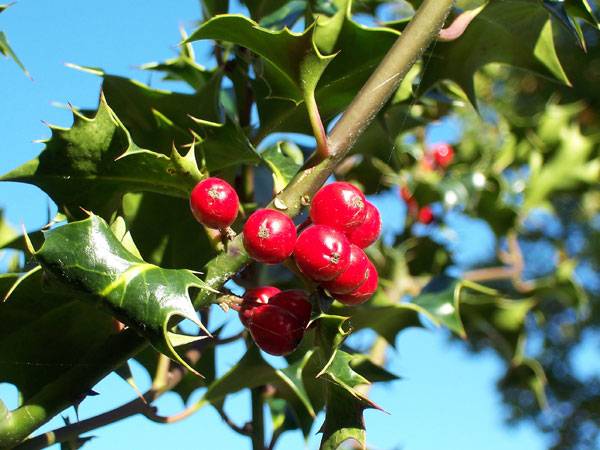
European Holly (Ilex aquifolium) leaves and fruit. Photo credit: Jürgen Howaldt. Licensed under 2.0. Image source.

The Canadian flag flying at the Maritime Museum of the Atlantic in Halifax, Nova Scotia. Photo credit: Jared Grove (Phobophile). Licensed under CC 3.0. Image source.
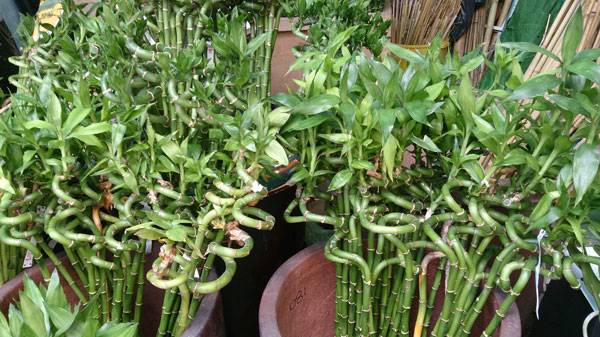
“Lucky Bamboo (Dracaena braunii) 1” by Mokkie – Own work. Licensed under CC BY-SA 3.0 via Wikimedia Commons
Is The Eden Project the Birth of a New Beginning?
Eden Project, in Nicholas Grimshaw and Partners, Tim Smit, Arup Engineering, in Cornwall, United Kingdom. Once an open clay pit, the Eden project in Cornwall, United Kingdom, today represents one of the most beautiful examples of a recultivated surface mine. The pit was mined for more than 160 years; in 1995, the original idea for the Eden project was born. The once desolate area is now home to attractions such as the Malaysian House, Rainforest Aerial Walkway, Pollination (and the Giant Bee), Grapevines (with Dionysus), Olives (gold path with doves), Biomass Fuels, Myth and Folklore, Wild Cornwall, and The Core with The Seed. It is not surprising that in its first few months after opening in 2001, Eden was visited by more than a million people! The number of visitors has increased each year, and the project continues to delight us. So how did it all begin? WATCH >>> Rainforest in the Eden Project
The Eden Project
Early Vision of the Project The main idea of the project was to create a place where cultivated plants from all over the world could be displayed. Tim Smit, an archeologist who wanted to create something to amaze future generations, came up with the idea of filling the 60-meter-deep pits with new life. It took six years to bring the project to fruition. Eden: Heaven on Earth The very name of the project speaks of a kind of paradise on Earth. At the entrance, a winding road leads to the domes, around which are planted numerous plant species, as well as sculptures and robots made from old equipment.
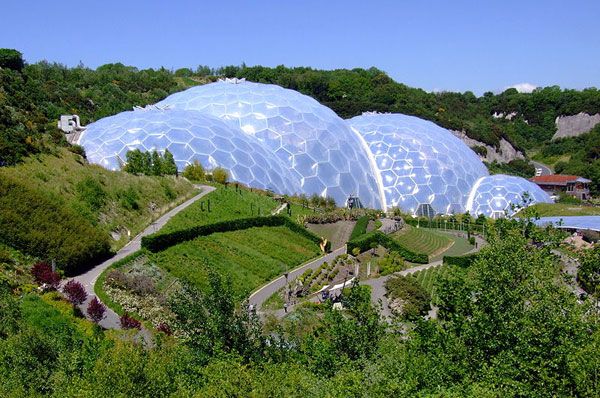
The iconic bio-domes of the Eden Project, Cornwall, England. Photo credit: originally posted to Flickr as The Biomes. Author – Jon. Licensed under CC-SA 2.0. Image source.
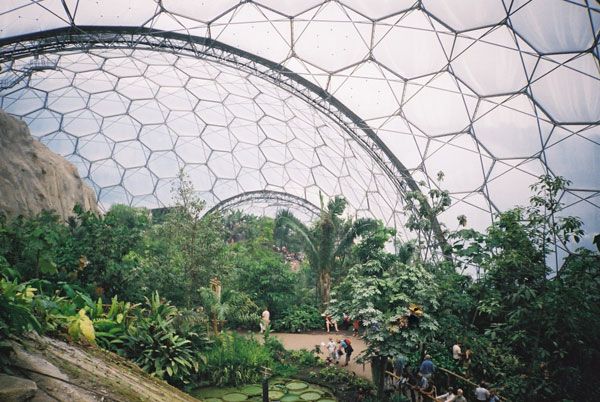
Inside the Humid Tropics Biome at the Eden Project, Cornwall. Photo credit: Author – Stevekeiretsu. Licensed under CC-SA 1.0. Image source.
- The Stunning Yanweizhou Park Recaptures Lost Ecology
- Exceptional Ecological Park Reconnects Children With Nature
- Lotus Lake Park Sets Precedent for Sustainable Urban Design in China

Nicolas Grimshaw: Iron Structural Meshes of Eden Project, Saint Austell (Cornwall). Photo credit: Piergiorgio Rossi. Licensed under Public Domain. Image source.
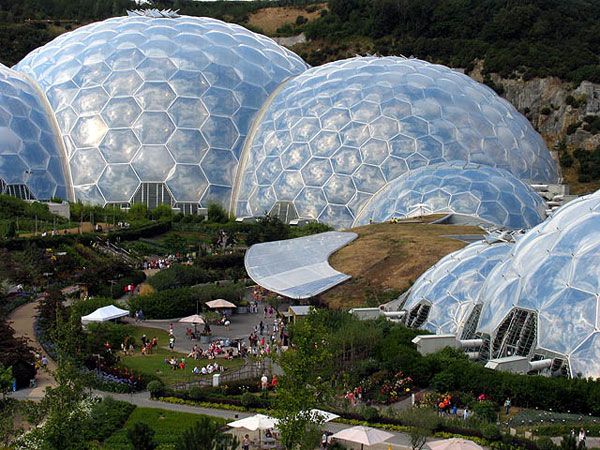
The Eden Project. This is a view from the entrance building, looking towards the humid biomes and the section connecting the humid and the other biomes. Photo credit: Pam Brophy. Licensed under CC-SA 2.0. Image source.
The Philosophy Behind The Eden Project
The whole philosophy of Eden is based on the preservation of the environment and recycling. Everything — from all the boxes for the purchase and delivery of plants to the design of equipment — has the characteristics of reuse. Even the food that is eaten has been specially selected with sustainability in mind. Harvesting Water for Sustainability The other important sustainable fact is water harvest. Water is essential for maintaining humidity in every biome and rainwater is collected at the bottom, thanks to an underground drainage system. About two-thirds of the water used in Eden comes from water collected on site. Designing with Nature Architectural constructions are strictly made from recycled materials and lower-carbon products. The goal is to try to keep the environmental impact of the buildings very low. One of the most important is The Core, which was built in accordance with the natural architecture – biomimicry. It is in the form of a sunflower. It was built in March 2003 and serves as an educational center with classrooms. The Core Structure The Core structure is based on Fibonacci numbers — the pattern found in all natural forms, such as pinecones, sunflower heads, and snail shells. On the roof are solar panels that collect solar energy. The main building material is timber. Inside The Core, there are many things to see, including the giant nutcracker, the seed, areas for playing, and video projections of how Eden was built.
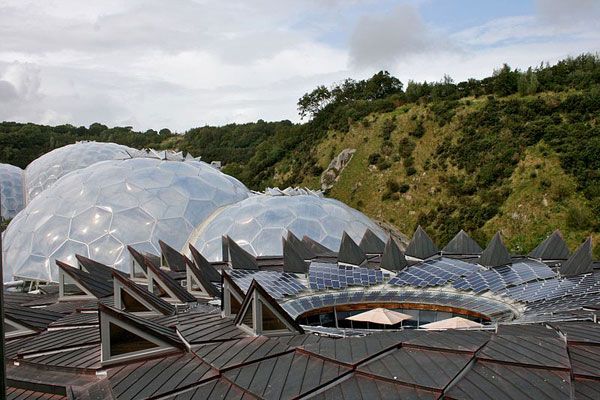
The Eden Project; foreground is the roof of The Core. Photo credit: Photograph by Mike Peel (www.mikepeel.net). Licensed under CC-SA 4.0. Image source.
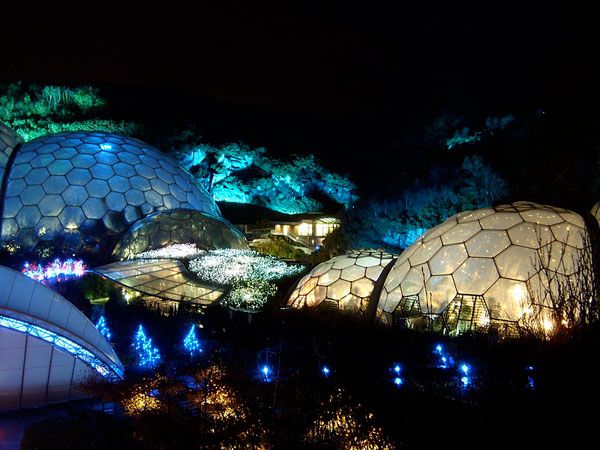
Eden Project Winter 2008 showing Bruce Munro field of Light. Photo credit: Author – Mark Vallins. Licensed under CC-SA 3.0. Image source.
- The Rainforest Biome is the largest indoor rainforest in the world, with more than 1,000 varieties of plants. It takes 1.5 hours to see everything.
- The huge model of a bee in the Outdoor Gardens stands there as a reminder of how important pollinating insects (such as bees) are to flowers – and to humans.
- Tim Shaw’s sculptures amid the grapevines in the Mediterranean Biome depict the myth of Dionysus, Greek god of the vines.
- The WEEE Man by Paul Bonomini is a 3.3-ton structure that represents the amount of waste generated by electricity and electronic equipment.
- The Outdoor Gardens cover more than 20 acres, with more than 3,000 varieties of plants. It takes two hours to see most of the gardens.
- The Eve sculpture is a living sculpture made mostly of clay from Eden itself.
- The world’s biggest, smelliest flower (Titan arum) is in the Rainforest Biome.
- In September 2009, Eden opened a wedding venue in the Rainforest Biome.
- In August 2009, Sir David Attenborough filmed a wildlife documentary – “Flying monsters 3D” – in Eden.
- Eden offers a number of courses for both children and adults in horticulture and botany, workshops, volunteer opportunities, work opportunities, and various events throughout the year (concerts, exhibitions, etc.)
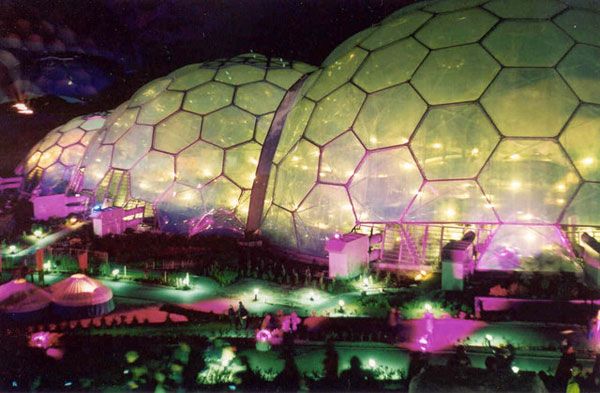
“The Eden Project, at Night. At first glance you might think that you are looking at something out of “The Quatermass Experiment,” but in fact these are the Biomes at the Eden Project taken late at night after my wife and myself had been to the Last Night of the Proms Concert which was linked up to the Royal Albert Hall in London“. Photo and text credit: Neil Kennedy. Licensed under CC-SA 2.0. Image source.
Recommended Reading:
- Landscape Architecture: An Introduction by Robert Holden
- Landscape Architecture, Fifth Edition: A Manual of Environmental Planning and Design by Barry Starke
Article by Amela Djurakovac
Featured image: Eden Project Winter 2008 showing Bruce Munro field of Light. Photo credit: Author – Mark Vallins. Licensed under CC-SA 3.0. Image source.
Discover the Ancient Secrets of the Physic Garden
The Physic Garden by Thorbjörn Andersson with Sweco Architects, Novartis Campus, Basel, Switzerland. Have you ever wondered what secrets have been hiding in monastery gardens or at least wanted to experience the mystique that they bring? If your answer is yes, you will probably want to visit The Physic Garden by Thorbjörn Andersson and see the main features of this historically important garden that — even when they were inaccessible — held significance for the community. Located in Basel, Switzerland, this simple but effective garden has a lot to show. It is designed to be part of the Novartis Campus and to describe the work of the company, which discovers, develops, and markets innovative products to prevent and cure diseases, ease suffering, and enhance the quality of life. Over 2,800 square meters, Thorbjörn Andersson and the team have created a garden that exudes history, symbolism, color, and rhythm and leaves space for reflection, relaxation, and education.
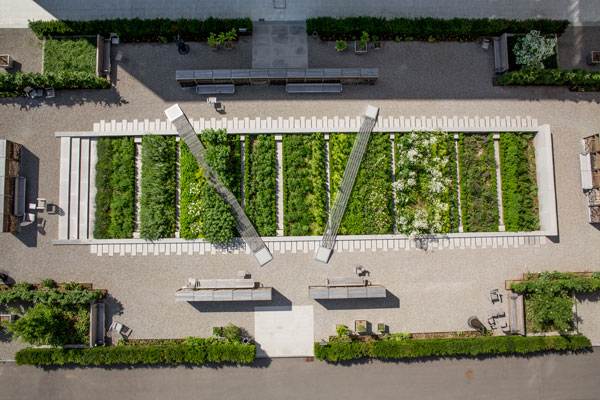
The Physic Garden. Photo credit: Jan Raeber
The Physic Garden
The Physic Garden is formally designed, rectangular shaped and semi-enclosed. It consists of two parts: the central garden, which is divided into strips, and the space around the central garden, which also has a special symbolic meaning. The whole garden is permeated with symbolism, so it is not surprising that every plant and every used material have been placed here for a reason. Strips located in the central part separate flowerbeds, where different types of plants used in pharmacy are sown.
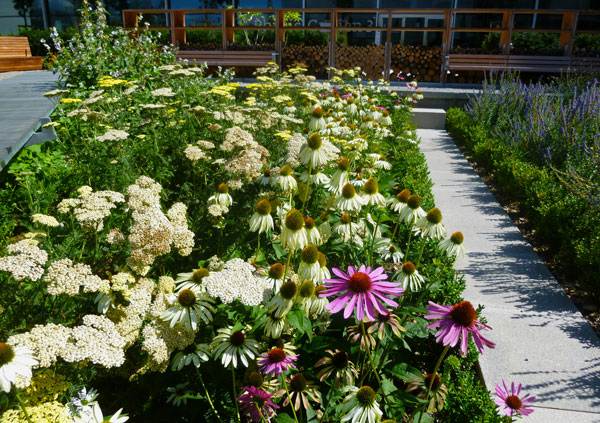
Plants at the Physic Garden.Photo credit: Thorbjörn Andersson
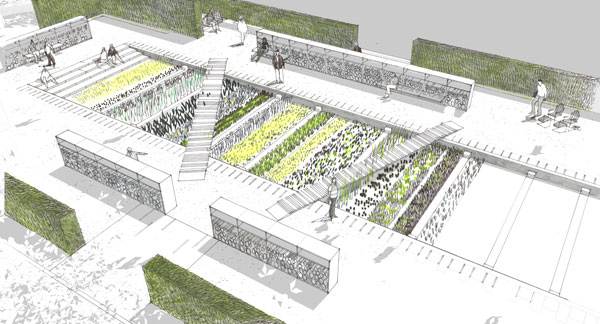
The Physic Garden. Image credit: Thorbjörn Andersson with Sweco Architects
Walking trough the floral carpet at the Physic Garden
Over the flowerbeds are two zig-zag walking paths that also symbolically represent “a walk through the garden”. Walkers can view the plants from above. If you want to learn something about them or even explore and study them, you can read the name of each plant on signage throughout the flowerbeds.
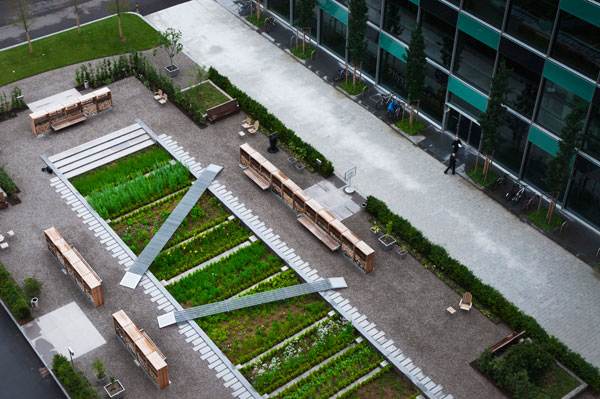
The Physic Garden. Photo credit: Thorbjörn Andersson
- Lotus Lake Park Sets Precedent for Sustainable Urban Design in China
- Contemporary Landscape Architecture in China: Beautiful or Dangerous?
- Awesome Plaza Shows You Why China Are World Leaders in Landscape Architecture
The garden also has water elements through an artistic shaped amphora and a place for seating in the form of a wooden pavilion with parts such as bookshelves, a hedge with different heights around the garden, and movable flowerpots.
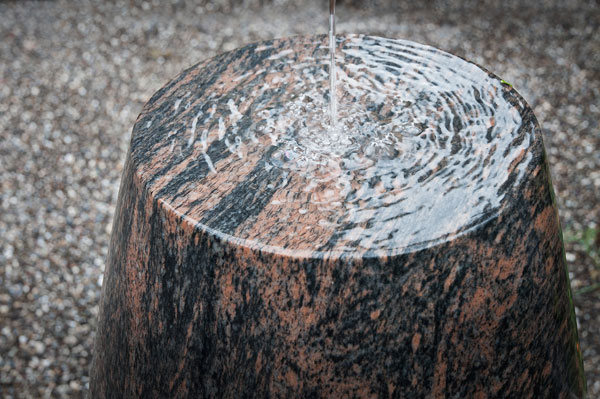
The Physic Garden. Photo credit: Thorbjörn Andersson
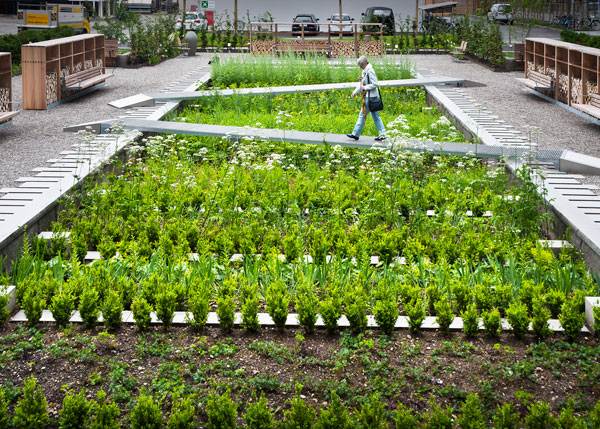
The Physic Garden. Photo credit: Thorbjörn Andersson
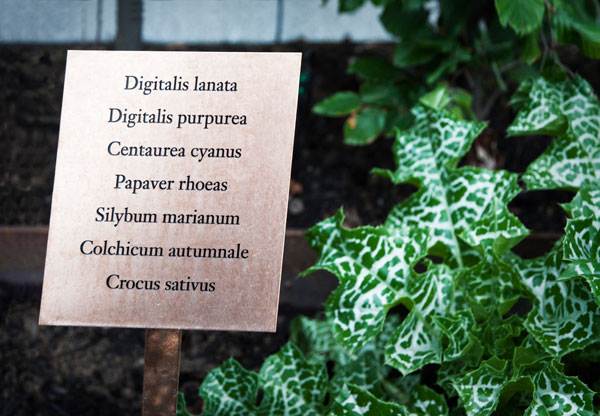
The Physic Garden. Photo credit: Thorbjörn Andersson
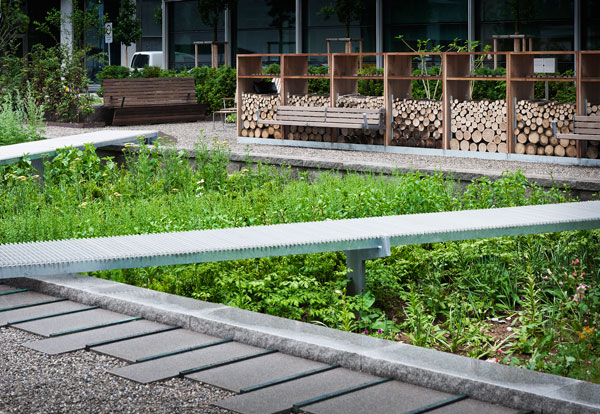
The Physic Garden. Photo credit: Thorbjörn Andersson
- Urban Design by Alex Krieger
- The Urban Design Handbook: Techniques and Working Methods (Second Edition) by Urban Design Associates
Article by Amela Djurakovac Return to Homepage
Daycare Centers Embracing Modern Design
Quezon Daycare Center, by Yuusuke Karasawa Architects, Quezon, Republic of the Philippines. Besides being the largest and most populous city in the Republic of the Philippines, Quezon is known for its many cultural and historical sights and landmarks. Included in the territory of Quezon are 272 city government-owned daycare centers. For one of them, architect Yuusuke Karasawa made a modern, multifunctional project that will completely improve the quality of people’s life. Construction of the Karasawa project in the city northeast of Manila is planned for 2015.
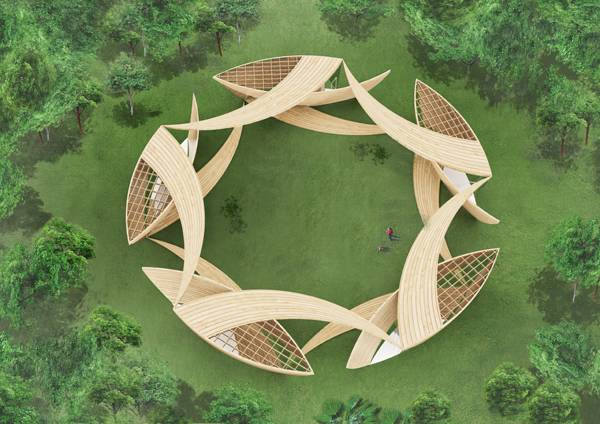
Credit: Yuusuke Karasawa Architects
In terms of daycare centers what makes this so special?
Besides the multi functionality and design, the Quezon daycare center is special because the architect has created a unique network that will connect people in their daily activities and encourage communication. In addition to providing care for children, the center also was designed to host various public and private events.
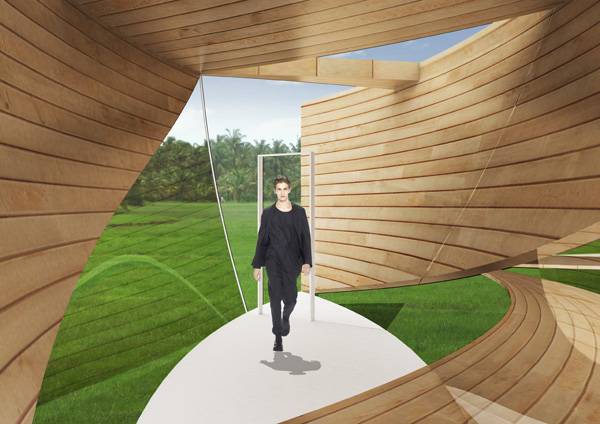
Credit: Yuusuke Karasawa Architects
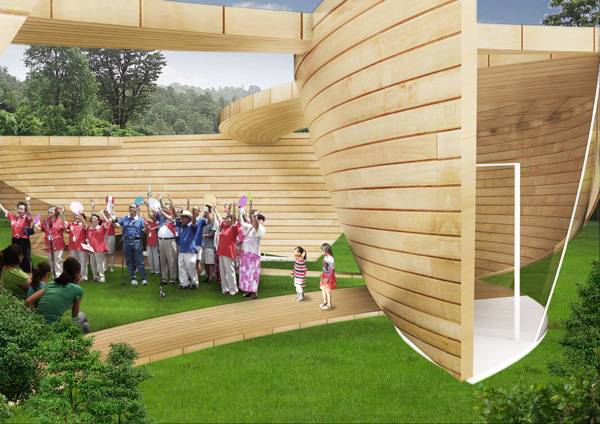
Credit: Yuusuke Karasawa Architects
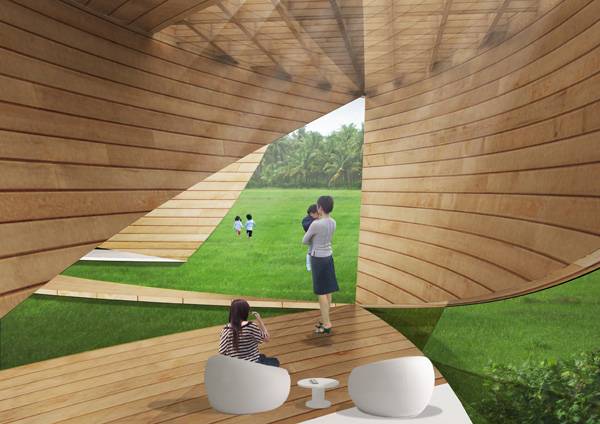
Credit: Yuusuke Karasawa Architects
The Future of Multipurpose Daycare Centers
Designing a multipurpose space nowadays is a real challenge, because you need to create places that combine different functions in one space while keeping in mind how the space will affect the quality of life of the people who live with the design each day. Related Articles:
- Exceptional Ecological Park Reconnects Children With Nature
- How to Grow a School Garden – Book Review
- Crown Sky Garden Inspires Healing
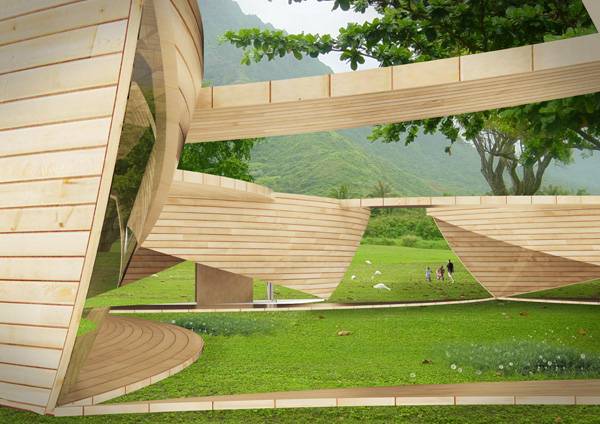
Credit: Yuusuke Karasawa Architects
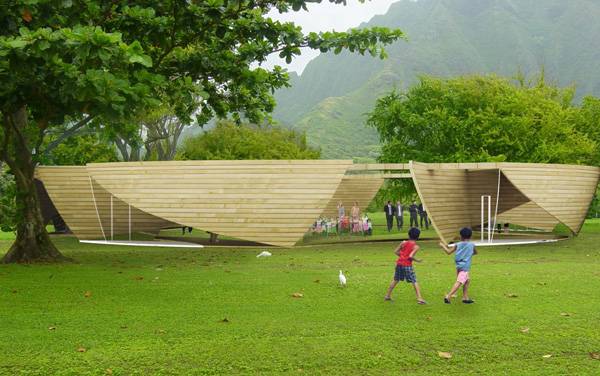
Credit: Yuusuke Karasawa Architects
- Playground Design (Architecture in Focus) by Michelle Galindo
- The Science of Play: How to Build Playgrounds That Enhance Children’s Development by Susan G. Solomon
Article by Amela Djurakovac Return to Homepage


